Late last month, Malaysia’s defense minister confirmed that Kuala Lumpur was still considering a fighter jet exchange deal with Russia that had previously been in the headlines. The comments once again spotlighted one of the areas of Malaysia-Russia security relations that continues to attract speculation.
As I have observed before in these pages, while Malaysia is no stranger to Russian defense equipment, Malaysia’s experience with Russian-made fighter jets illustrated the challenges inherent in Malaysia-Russia defense cooperation. Malaysia has been operating Sukhoi Su-30MKM and MiG-29 fighter jets, and various issues related to their maintenance and servicing have surfaced over the years. Defense Minister Mohamad Sabu publicly revealed last year that only four of 18 Sukhoi planes were working.
Since then, there have been efforts by both countries to attempt to work through these challenges as part of wider security collaboration. And one of the arrangements that had previously surfaced was one where Russia would take back the older aircraft in exchange for newer ones. In September, Malaysian Prime Minister Mahathir Mohamad had said that such a deal would need to be considered given the fact that it would be difficult to sell the older aircraft.
Last week, Malaysia’s position with respect to Russian aircraft was in the spotlight again with remarks by Defense Minister Mohamad. In response to a question in parliament, he confirmed that Malaysia had received an aircraft exchange deal from Russia and that Malaysia was still considering it.
Specifically, when asked directly in parliament whether Malaysia would be willing to accept the Russian government’s offer to take back older jets and replace them with new aircraft, Mohamad suggested that the offer was under consideration. He also added that the acquisition of multirole combat aircraft was currently not in the defense ministry’s plans – which call for assets such as maritime patrol aircraft, unmanned aerial vehicles, and light combat aircraft to add to its capabilities – and that Malaysia would continue along the lines of the RMAF’s existing priorities, including maintaining older, existing aircraft such as the Su-30MKMs and Boeing F/A-18 Hornets out to 2030.
Mohamad did not offer more details on either the offer or the specific considerations at play in the Malaysian government’s evaluation of it, be it the terms offered by Russia themselves or wider political considerations. This is unsurprising given the sensitivities involved with the deal, the headlines it has previously attracted, and the current state of Malaysia’s defense policy. The release of Malaysia’s defense white paper has only increased scrutiny on the government’s decisions in this respect. Until such details are publicly disclosed, one can expect that the speculation will continue about the future of the deal as well as what it says about Malaysia’s defense relationship with Russia and its future security outlook.

































